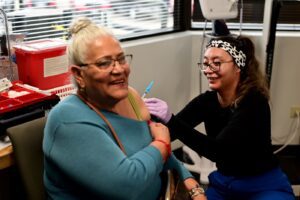Atopic dermatitis (AD) affects an estimated 10.7% of children and 7.2% of adults in the United States, with a preponderance of those affected non-Hispanic Black patients.1,2 Compared with children of European descent, findings have shown that the odds of developing AD are 1.7 times greater among African American children, who are 3 times more likely to receive an AD diagnosis during a dermatology consult.3
Gaps in treatment access and quality of dermatology care have been noted between Black and non-Black patients. A cross-sectional study published in the Journal of the National Medical Association found that Black patients were significantly less likely to receive emerging and frontline therapies for AD as well as acne and psoriasis.4,5 Among Black patients with AD who do have access to care, the likelihood of severe disease is greater (about 6 times higher than in Black vs White children), and rates of healthcare utilization and hospitalization are higher compared with White patients.6,2
These disparities can be attributed to a range of contributing factors, according to Shawn Kwatra, MD, assistant professor of dermatology at the Johns Hopkins University School of Medicine in Baltimore and coauthor of numerous papers on this topic.5,6 “While there are certainly systemic issues in healthcare utilization, there are also biological reasons for these observed differences,” he told us in a recent interview.
“Erythema is more difficult to detect in Black skin which can lead to a delay in detection and treatment,” Dr Kwatra noted. Common scoring instruments for AD that rely on erythema, such as SCORAD, severely understate disease severity in patients with dark skin. In these patients, erythema may appear violaceous, and the presence of scale, edema, or skin warmth can further indicate underlying erythema.7
In addition, AD “has a unique clinical phenotype in Black skin, with greater involvement of the extensor surfaces and more thickened skin lesions that are more popular,” said Dr Kwatra. There is a lichen planus-like type of AD that occurs exclusively in this population which lacks lichenification and shows a rapid treatment response.7
He also points to studies suggesting differences in genetic susceptibility to AD, specifically regarding filaggrin (FLG) mutations, which are 6 times less likely to be found in African Americans compared with other patient groups.3 Although R501X and 2282del4 are the 2 most common FLG gene mutations identified in those of Asian and European descent, these mutations are less often observed in people of African descent.6 Researchers are currently investigating the types and role of FLG mutations in AD in Black patients.
Recent studies have explored the role of African genetic ancestry in AD susceptibility and severity, including analyses of 2 large cohorts that demonstrated no association between African genetic ancestry and AD risk or severity, and AD disparities were not attributable to an AD polygenic risk score or genetic skin pigment score.8 However, there are many limitations associated with these results, including the vast underrepresentation of patients of African descent in studies investigating the role of genetic factors in AD.9 This group comprises only 0.7% of participants in genome-wide association studies of AD, underscoring the tremendous remaining needs in this area.2
“In addition, atopic dermatitis in [Black patients] has Th2 as well as varying elements of Th22 and Th17 involvement, suggesting broader immune activation,” Dr Kwatra explained. “Finally, there are structural differences in Black skin, which has increased trans-epidermal water loss and larger mast cells.”
Studies have also found links between an elevated AD risk and certain environmental factors including living in a metropolitan area, which is “likely due to differences in environmental pollution, contact with tobacco smoke, hygiene practices, diet, rates of breastfeeding, and exposure to infectious disease,” as stated in a paper published in Experimental Dermatology.7
Although Black patients have been underrepresented in trials investigating AD therapies, the limited available data generally indicate comparable efficacy for common AD therapies in Black and non-Black patients, and treatment recommendations are largely similar across all racial and ethnic groups. However, there are important considerations specific to AD patients with more pigmented skin types.7
That is, topical corticosteroids can cause hypopigmentation in dark skin, and higher doses of narrowband (NB)-UVB are needed for these patients when UVB treatment is indicated.7 Dr Kwatra adds that low pH “skincare products should be used instead of alkaline soaps to protect the stratum corneum and better hydrate the skin.”
The sum of evidence regarding AD in Black patients highlights the importance of clinician competence in treating patients of various racial and ethnic backgrounds, as well as the critical need for greater inclusion of diverse populations in trials investigating the pathophysiology and treatment of AD.
References
1. Avena-Woods C. Overview of atopic dermatitis. Am J Manag Care. 2017;23(8 Suppl):S115-S123. PMID:28978208
2. Daya M, Barnes KC. African American ancestry contribution to asthma and atopic dermatitis. Ann Allergy Asthma Immunol. 2019;122(5):456-462. doi:10.1016/j.anai.2019.02.009
3. Brunner PM, Guttman-Yassky E. Racial differences in atopic dermatitis. Ann Allergy Asthma Immunol. 2019;122(5):449-455. doi:10.1016/j.anai.2018.11.015
4. Rodriguez T. Expert roundtable: racial disparities in dermatology care. Dermatology Advisor. November 5, 2020. Accessed online February 22, 2021.
5. Bell MA, Whang KA, Thomas J, Aguh C, Kwatra SG. Racial and ethnic disparities in access to emerging and frontline therapies in common dermatological conditions: a cross-sectional study. J Natl Med Assoc. 2020;112(6):650-653. doi:10.1016/j.jnma.2020.06.009
6. McColl M, Boozalis E, Aguh C, Eseonu AC, Okoye GA, Kwatra SG. Pruritus in black skin: unique molecular characteristics and clinical features. J Natl Med Assoc. 2021;113(1):30-38. doi:10.1016/j.jnma.2020.07.002
7. Kaufman BP, Guttman-Yassky E, Alexis AF. Atopic dermatitis in diverse racial and ethnic groups-Variations in epidemiology, genetics, clinical presentation and treatment. Exp Dermatol. 2018;27(4):340-357. doi:10.1111/exd.13514
8. Abuabara K, You Y, Margolis DJ, Hoffmann TJ, Risch N, Jorgenson E. Genetic ancestry does not explain increased atopic dermatitis susceptibility or worse disease control among African American subjects in 2 large US cohorts. J Allergy Clin Immunol. 2020;145(1):192-198.e11. doi:10.1016/j.jaci.2019.06.044
9. Kumar R, Seibold MA, Burchard EG. Atopic dermatitis, race, and genetics. J Allergy Clin Immunol. 2020;145(1):108-110. doi:10.1016/j.jaci.2019.11.008
This article originally appeared on Dermatology Advisor





